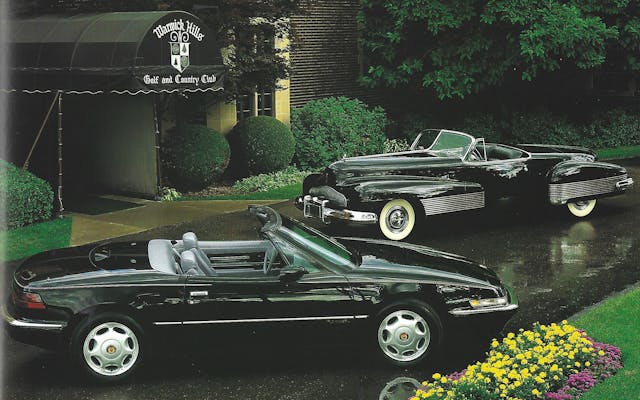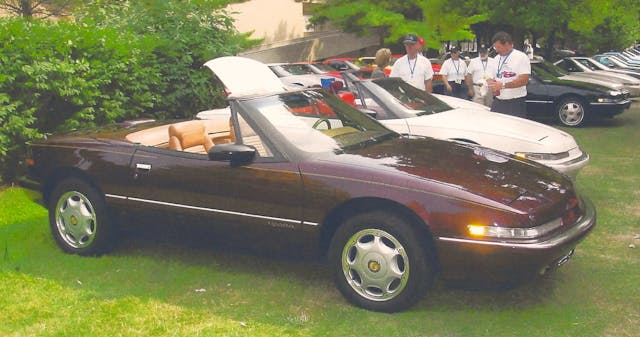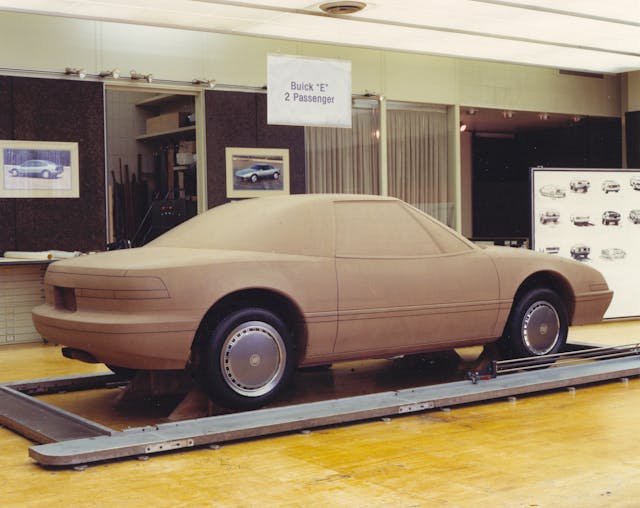The Cool Car Chronicles: My Life and Times with the Buick Reatta
Four years before I acquired a Reatta, I found myself planning and executing the magazine press preview event for that very nice yet largely unappreciated Buick two-seater. In 1987, after eight years as an auto engineer with Chevrolet and GM—interrupted by three years of U.S. Navy service—and 14 as a busy auto writer, I had accepted an offer to establish and run a western-area PR and media relations office for GM’s Buick Motor Division.
I had never done or trained for PR or event management but had attended countless such events as media, and it helped greatly to be married to a highly effective auto PR pro. Using my media experience and her as a role model, I felt I could learn the job fairly quickly and do it reasonably well. And I arrived in that new job just in time to plan and execute that important press event to kick off the media launch of Buick’s first-ever two-seat sporty coupe.
My Reatta

But my Reatta ownership began more than four years later, soon after the car had been killed for lack of sales and negative profit. Buick had made substantial improvements to it for ’91, including an upgraded, 170-hp “Tuned Port Injection” 3800 V-6 coupled to an electronically controlled four-speed automatic, plus larger wheels and tires, a console cupholder, and, for the convertible, anti-shake add-ons and a power pull-down for the (previously manual) top.
But, as usual for GM of the 1980s and ’90s, those improvements came too late, and on March 5 of that year, GM president Lloyd Reuss—who had fathered the Reatta first as Buick chief engineer then as general manager—announced that it was canceled and would be replaced at the Lansing Craft Centre by a sophisticated electric vehicle. Just 1520 Reattas were built for 1991—305 of which were convertibles.

And because the ragtop Reatta introduced for ’90 had been plagued by a troubling amount of body shake due to its Riviera-based platform’s lack of structural stiffness, Buick engineers tested those 305 somewhat strengthened ’91 convertibles for shake on a variety of surfaces and divided them into three groups based on the results. Those testing good enough for public sale were shipped to dealers; those (62 cars) judged too shaky for anyone were scrapped; and the middle group of 115 were offered for sale to employees at a friendly price.
In my role as the western PR guy, I had driven Reattas often since the car’s 1988 launch, loaned them to media for (mostly good) reviews, demonstrated and defended their unique and highly capable—but slow and complex—TV-like cathode-ray tube (CRT) infotainment system and the ’90 convertible’s manual top, which could be lowered and raised quickly and easily once you knew how to do it. And I really liked the car for its handsome look, its pleasing dynamics, and the positive public reactions it earned in car-crazy California.



So, I applied to purchase one of those shake-tested, “good enough for employees” ’91 convertibles and was thrilled to be offered one of just 13 that had been built in a beautiful Claret Red color. And because that opportunity arrived when I was preparing to transfer from Buick back to the engineering side as vehicle test and development manager for GM’s start-up electric vehicle group, I was able to drive that beauty as my company car for its first three months, then purchase it at a substantial discount. That GM EV group evolved into its Advanced Technology Vehicles (ATV) division and, eventually, after a long delay while GM nearly went bankrupt in 1992–93, produced the technologically brilliant but poor-selling EV1 battery electric coupe in that very same Lansing Craft Centre.
First Taste
Actually, my first taste of Reatta happened nearly a year before its public introduction. Buick PR ace (and historian) Larry Gustin had invited me and then-Motor Trend editor Tony Swan to Phoenix for an off-the-record sneak peak of the soon-to-come two-seater. They wanted our feedback, so we drove pre-production examples and provided our opinions.
We were unsure of what to expect. To properly fit the Buick mold, it would probably not be a muscular Corvette or high-zoot Cadillac Allanté competitor but likely a softer, plusher, slower, less exotic, and more affordable car than both. We were right on all counts . . . and pleasantly surprised by how much we liked it, beginning with its appealing good looks. And we found it more agile and better glued to the road than any Buick before it. On the other hand, we were disappointed by its complex CRT-dominated dash and the middling performance of its 165-hp V-6, both inherited from the ’86 Riviera on which it was based.
I hadn’t thought of that day as a job interview, but it may have been so at least partially, since it wasn’t much later that I was offered the PR opportunity. And, after spending the last 12 of my 14 auto-writing years as a hard-working self-employed freelancer, I was more than ready for a real job with real benefits, even if it meant going back to the corporate side.

Then, in planning the media preview, I figured the Reatta—essentially a shorter, lighter take on the Riviera’s “personal luxury” coupe platform, which offered a good-handling T-Type model—would please the writers on curvy California two-lanes but would be down on power on uphill stretches. So, I based the event up the coast from LA in lovely Santa Barbara, then invested considerable time exploring the roads around there and carefully selecting those that would best let our Reatta press cars shine. Creating that drive route was the fun part; the rest was hard work. But the event went well, and we got mostly good reviews.
As I have written here before, Buick’s sporty two-seater was conceived more than a decade before its birth, primarily by then-chief engineer Lloyd Reuss. It was proposed in 1980 by Reuss (by then Buick’s general manager), product planning chief Jay Qualman, and strategic planning manager Lynn Salata. Their plan to base it on a shortened front-drive “E-car” (Riviera/Olds Toronado/Cadillac Eldorado) platform and powertrain would keep its investment costs down.

Originally intended for a 1983 launch as an ‘84 model, the Reatta was delayed more than four years by the complex reorganization that folded GM’s five divisional marketing and engineering divisions into Buick-Oldsmobile-Cadillac (BOC) and Chevrolet-Pontiac-Canada (CPC) “super groups.” There were also engineering resource constraints, plus an agreement to let Cadillac get its own two-seat Allanté done first. Then, when it was finally ready for a January 1988 public launch, our PR challenge was to help media understand this very different new Buick was neither a Corvette nor an Allanté competitor and hope they would write kind words about it.
At $25,000, the Reatta was pricier than intended partly because E-body componentry had inflated in cost, but it also boasted nearly every conceivable feature as standard equipment. The only options were a power sunroof and a 16-way power driver’s seat. Just 4707 were built for 1988, and 7009 for 1989, as the price inflated to $26,700 and sales slowed as initial demand was satisfied.


Nineteen-ninety brought a much-improved instrument panel with electronic analogue gauges replacing the CRT. It also gave us the long-awaited convertible. Because the E-body had not been designed to have its top removed, it had taken nearly two additional years to engineer more strength into the shortened (by 9.5 in.) ragtop Reatta’s structure. The convertible drew media raves for its beauty and character but brickbats for its somewhat shaky body and its manual top, a complex design that narrowed in width as it dropped into a well under a hard tonneau cover. Other changes included the addition of a power steering cooler and a driver’s side air bag.
That was the Reatta’s biggest production year, with 6383 coupes and 2132 convertibles assembled by teams at the Lansing Craft Centre. But Buick’s upscale two-seater was proving a difficult sell in a soft market unkind to impractical image cars in general. It was also a major money loser given its high cost, low volume, and dedicated plant. Still, it got another price increase, to $28,335 for the coupe and a whopping $34,995 for the convertible. The four-year production total after the curtailed 1991 model year was 21,750—19,314 coupes and 2437 convertibles.

I loved my pretty dark-red Reatta convertible and kept it for many years—stored in a farmer’s barn beside the ’67 Corvette my wife and I had bought in 1990—as a pleasing occasional driver, top-down when possible, and a potential future collector car. But I eventually needed the money so had to sell it.
Buick’s Reatta was a finely styled, fully equipped, delightful-to-drive, two-seat sporty car (with a real, usable trunk) that was narrowly targeted at a select group of buyers with discretionary income. It was also widely misunderstood. Some expected a Buick “Corvette.” Others, a lighter, less expensive sports car than it was. In reality, it was a half-price Mercedes SL (or Cadillac Allanté) luxury tourer with no direct competitor save the dismal and short-lived Chrysler TC by Maserati. It was another very cool car I would love to have back one day, but in the same pristine condition it was in when I reluctantly parted ways with it.






During the years that I drove company cars, it was mandatory to replace them every 3 months, rotating through the GM brands while doing so. For 4 years in a row, I selected a Buick Reatta when it was time for a Buick. While driving one along I-101, in Northern LA County, I got pulled over by a CHP (Calif. Highway Patrol) assuming that it was for speeding, which would not be unusual for me. I was pleasantly surprised that the reason the officer had pulled me over was that he had never seen a Reatta and was curious about it. After chatting for a few minutes answering his numerous questions, he thanked me and let me on my way. I wished that all highways patrol encounters would have been as pleasant.
Nice styling, but unfortunately it missed the mark with a limited number of buyers. About 2 years ago I was looking for a commuter car, and I was keeping my eyes open for a Chrysler TC, which I found very appealing, especially with a DOHC engine and 5-speed transmission, which was not an option with Buick. I ended up buying a 2004 Chrysler Sebring convertible, and my biggest complaint is that it doesn’t have a manual transmission. My second biggest complaint is that the seats are too firm. I think brands like BMW, Mercedes-Benz, Porsche, and Audi are simply building the cars that check the right boxes for car enthusiasts, which makes me wonder, where have all the leaders gone? (That was the title of a book written by Lee Iacocca)
I have a ’97 Riviera (my mom’s last car). I’d bet that had Buick mated a supercharger to the 3800 in the Reatta, the performance would have been something to notice.
When I took delivery of the supercharged Riviera for my mom, I’d already been driving my ’95 Eldo for a couple of years. I was pleasantly surprised by the performance of the supercharged 3800 compared to my normally aspirated Northstar.
My mom sort of missed the Reatta availability, as she was in an ’89 Regal GS which came off lease in ’93. At that time, the Reatta was no longer an option, so she got into a Regal Custom until ’97, when she got her Riviera. She would have definitely gone for a Reatta.